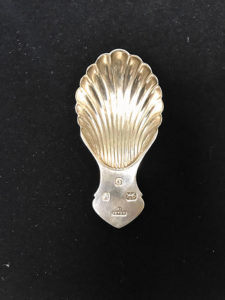 By Anne Gilbert
By Anne Gilbert The antiques world is filled with fancy names and descriptions, many in French, even for Asian antiques. What appears to be the simplest object, may not be described in a simple way on the internet or in an antique shop. For instance you see a small, silver spoon in an unusual shape. It is labeled “caddy” spoon. Guess what? It has nothing to do with golf.
Welcome to the world of “antiquese.” One of my favorite terms is “squab.” This doesn’t refer to a game bird, but removable stuffed cushions used on 17th and 18th century French chairs. So, when a dealer tells you about the striped squab on his Bergere, clever you will know he is referring to French, upholstered easy chair with a striped cushion.
What about a wall pocket? This is a term for a ceramic flower-vase meant to be attached to a wall. They are also known as “cornucopia.”
There are some surprises when you actually break down a term. For instance, the elegant “Cheval” glass (a full length mirror) translates into “horse mirror.” It is literally a mirror large enough to reflect a horse.
What about a vase labeled “Sang-de-bouef?” That translates into the dark, red color as “blood of the ox.” It was a color developed during the Chinese, Ch’ing dynasty, late 18th century.
Perhaps an unusual textile catches your eye. It is labeled “Tibetan Tanka.” That’s an easy one. Doesn’t everyone know a Tanka is a religious, woven Buddhist image?
CLUES: Consider the snobbish point of view. When those fancy names are dropped at a social event, you wouldn’t want anybody to think you didn’t know what a “voyeuse” is? Imagine your embarrassment if you thought it was the plural of voyeur. Actually, it is a chair with a padded top attached to the back, for an observer to lean on, while the chairs’ occupant played cards.
When various pieces of Chinese ceramics are illustrated in an auction catalog with descriptions, you will find that French descriptive names are used. “Famille noir” refers to porcelain with a black background. “Famille rose” consists of pink, red and rose colors on the piece. “Famille verte” is green.
Other types of ceramic pieces have fancy name descriptions, many also in French. A good example would be a “pate-sur-pate” porcelain vase. It was a painting technique used in the 19th century by Sevres, Meissen and others. The effect is of a cameo, in slight relief.
Auction catalogs often have descriptions or check the internet.
PHOTO: Silver tea caddy spoon Timegazerantiques. Rochester Hills, Michigan















Follow Us